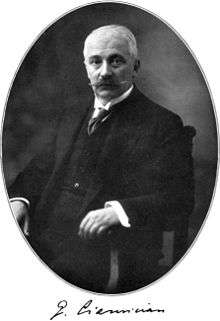Giacomo Ciamician
Giacomo Luigi Ciamician (Armenian: Հակոբ (Ջակոմո) Լուիջի Չամիչյան; 27 August 1857 – 2 January 1922) was an Italian photochemist and senator of Armenian descent.[2][3]
Giacomo Ciamician | |
|---|---|
 | |
| Born | 27 August 1857[1] |
| Died | 2 January 1922 (aged 64) Bologna, Italy |
| Education | University of Vienna |
| Employer | University of Bologna |
| Known for | Photochemistry |
| Parent(s) |
|
Life and work
Ciamician was born in Trieste, Italy (then part of Austrian Empire) from Armenian parents.
Ciamician was an early researcher in the area of photochemistry, where from 1900 to 1914 he published 40 notes, and nine memoirs. He received his Ph.D. from the University of Giessen. His first photochemistry experiment was published in 1886 and was titled "On the conversion of quinone into quinol.[2]
In 1910 he became the first man born in Trieste to be nominated Senator, in the XXIII Legislation of the Kingdom of Italy.
In 1912 he presented a paper before the 8th International Congress on Applied Chemistry later also published in Science in which he described the world's need for an energy transition to renewable energy. Ciamician saw the possibility to use photochemical devices that utilize solar energy to produce fuels to power the human civilization and called for their development. They would not only make humanity independent from coal, but could also rebalance the economic gap between rich and poor countries. His vision makes him one early proponents of artificial photosynthesis.:[4][5]
"On the arid lands there will spring up industrial colonies without smoke and without smokestacks; forests of glass tubes will extend over the plains and glass buildings will rise everywhere; inside of these will take place the photochemical processes that hitherto have been the guarded secret of the plants, but that will have been mastered by human industry which will know how to make them bear even more abundant fruit than nature, for nature is not in a hurry and mankind is. And if in a distant future the supply of coal becomes completely exhausted, civilization will not be checked by that, for life and civilization will continue as long as the sun shines!'"'[6]
Ciamician received the honorary Doctor of Laws (DLL) from the University of Glasgow in June 1901.[7]
Ciamician died in Bologna.
See also
- Ciamician-Dennstedt rearrangement
Publications (selection)
- Ciamician, G.; Dennestedt, M. (1881). Ciamician synthesis of pyridines from pyrroles. Chem. Ber. 14. (1153).
- Ciamician, G.; Silber, P. (1901). Ciamician photodisproportionation. Chem. Ber. 34. (2040).
External links
References
- "Archived copy" (PDF). Archived from the original (PDF) on 2015-09-23. Retrieved 2015-08-27.CS1 maint: archived copy as title (link)
- Nasini, Raffaello; Brown, Reginald; Roe, Alfred; Miller, W. Lash; Hewitt, J. T.; Dawson, H. M.; Knecht, Edmund (1926). "Giacomo Luigi Ciamician". Journal of the Chemical Society. 129: 993–1050. doi:10.1039/JR9262900993.
- "Fuels from solar energy" (PDF). Retrieved 2008-03-18.
- Nicola Armaroli, Vincenzo Balzani, (2007). The Future of Energy Supply: Challenges and Opportunities. In: Angewandte Chemie. 46. pp. 52–66. doi:10.1002/anie.200602373.
- Vincenzo Balzani et al. (2008). Photochemical Conversion of Solar Energy. In: ChemSusChem 1, (1–2), pp. 26–58. doi:10.1002/cssc.200700087.
- Ciamician, G. (1912). The photochemistry of the future. Science. 36. pp. 385–394.
- "Glasgow University jubilee". The Times (36481). London. 14 June 1901. p. 10.